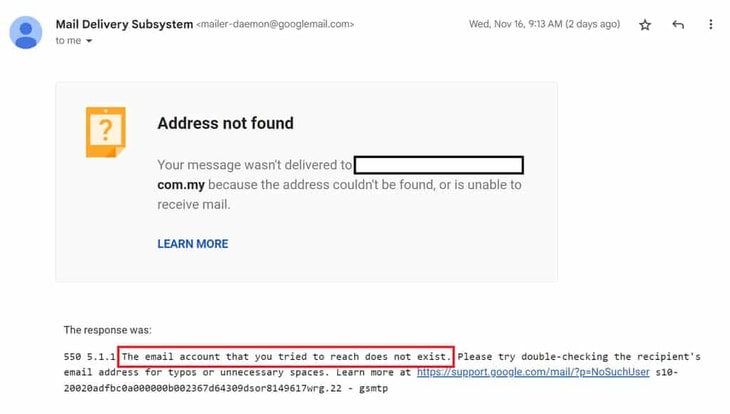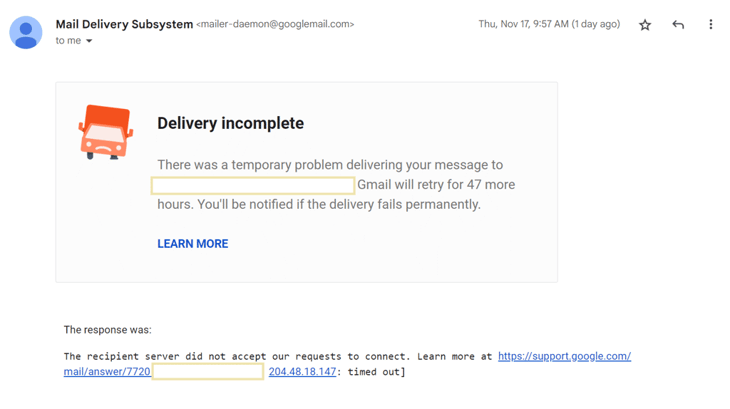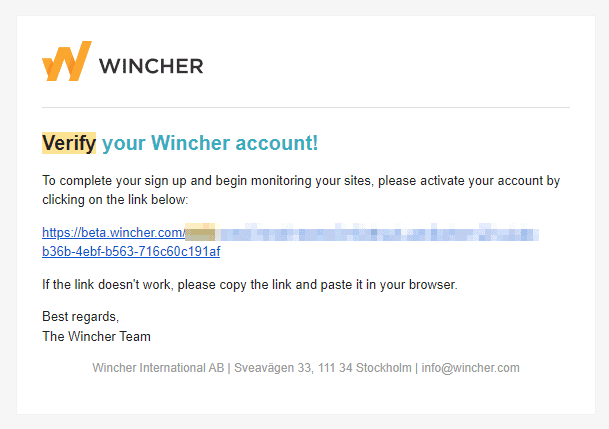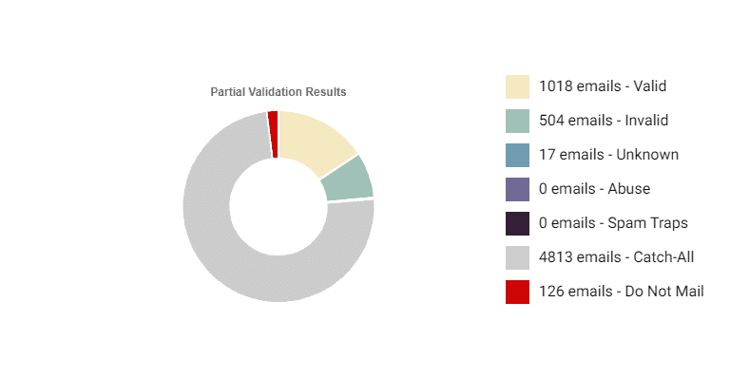Soft Bounce vs. Hard Bounce Email: 9 Proven Tips to Reduce Them
When you send an email, your intention is that it reaches your recipient’s inbox. But it doesn’t always work that way.
Some of the emails you send land in spam, but others bounce. What does it mean when your emails bounce? It means that email never reaches your target audience.
Did you know that 31 billion emails bounce every day?
It’s more than frustrating. Bounces diminish your sender reputation, hurting future changes of arriving in the inbox. Hard bounces and soft bounces affect your email deliverabilityⓘA sender’s ability to reach the recipient’s inbox with their outgoing emails. It may also describe the ratio of emails delivered to the inbox vs. those sent to spam or blocked by the receiving server. in different ways. We’re going to explore soft vs. hard bounces and how to stop them.
What is a soft bounce vs. hard bounce email?
When an email bounces, it means it wasn’t delivered to the recipient. There are various reasons for a bounce, whether on the recipient’s end or yours. There is a difference between hard and soft bounce emails.
So, what is a soft bounce in email? And what is a hard bounce in email?
- Soft bounce- when an email bounces due to a temporary issue.
- Hard bounce- when an email bounces due to a permanent issue.
So, what are some causes of a soft bounce?
A soft bounce happens when an email can’t be delivered temporarily. Here are some common reasons for the types of email bounces:
- Full mailbox: The recipient’s inbox has reached its storage limit and can’t accept new messages.
- Server issues: The recipient’s email server is temporarily down or experiencing problems.
- Image-only email: Emails with only images and no text can sometimes be rejected.
- Email too large: The message exceeds the recipient’s inbox size limit.
- Spam filtering: The email was flagged as spam and blocked.
- DNS issues: The recipient's email system is having trouble with domain name resolution.
What are some causes of a hard bounce?
A hard bounce happens when an email can’t be delivered for a permanent reason. Here are some common causes:
- Invalid email address: This is the most frequent reason. It could be due to typos, an incorrect domain, or a completely fake address.
- Non-existent domain: The domain part of the email address doesn’t exist because it was never registered or set up.
- Blocked by recipient server: Some email servers reject emails from certain senders, often due to spam filters or security settings.
- Closed email account: The recipient’s email account was deactivated or deleted.
- Incorrect formatting: Errors like missing the "@" symbol or having extra spaces make the address invalid.
- Poor sender reputation: If your emails frequently bounce, email providers may start blocking more of your messages.
- Strict corporate policies: Some companies use strong filters that prevent certain types of emails from being delivered.
Whether it’s soft or hard email bounces, they will affect your email deliverability. Regardless of the type of bounce, keep your bounce rates below 2% to prevent your email campaigns from going to spam.
Hard bounce vs. soft bounce: breaking it down
You now know the basic difference between a hard vs. soft bounce. But that’s just the tip of the iceberg.
Let’s look at each one in detail.
Why do emails hard bounce?
Hard bounces indicate a permanent issue with the email address you’re trying to reach. Here are some of the reasons why a hard email bounce could occur:
- The email address is invalid – due to either a mistype or fake email address.
- The email address is not in use anymore – it may have been abandoned and deactivated or deleted.
- The email server on the recipient’s end has blocked your delivery.

This is an example of a hard bounce email. Notice that Gmail also pointed out the bounce reason, specifying that the email account doesn’t exist.
With ZeroBounce’s email verification tools, you can identify and eliminate invalid addresses before they harm your campaigns.
“With hard bounces, the course of action is plain and simple: remove them right away,” says ZeroBounce’s Deliverability Team Leader Vlad Stoian.
Some email service providers (ESPs), like Mailchimp and HubSpot, will remove hard bounced emails from your database. That way, you can’t email them again.
“The downside, though, is that the damage is already done,” Vlad adds. ��“ESPs cannot predict which emails will bounce. Cleaning them after they bounce helps your future campaigns, but why risk getting bounces in the first place?”
The email deliverability pro advises:
“When your sender reputation is at stake, letting your ESP deal with your bounces isn’t enough. As a sender, it’s your responsibility to make sure you’re reaching out only to genuine email addresses.”
The best way to go about that is to remove invalid and fake emails before they can bounce and hurt your sender reputation. It takes only minutes for an email verifier like ZeroBounce to check your contacts and help you prevent hard bounces.
Why do emails soft bounce?
When your emails soft bounce, it means they haven’t reached your recipient’s inbox – but they might after several retries. Think of these emails as being somewhere in limbo. Some may make it to the mailbox, others will end up hard bouncing.

This is an example of a soft bounce email. Notice that Gmail says it will retry to deliver this email for 47 more hours. If Gmail fails to deliver it during that timeframe, it will convert this soft bounce into a hard bounce.
Here are some of the reasons your email could soft bounce:
- The recipient’s email is full.
- Your file may have been too large.
- Possible server outages on either end.
- The mailbox you’re trying to reach is inactive.
- The domain name does not exist.
- The recipient has spam filters that are blocking your email.
- The recipient’s email has been suspended.
- Your emails were reported as spam way too many times.
- You do not meet the Domain-based Message Authentication Reporting and Conformance (DMARC) policy
Although soft bounces are temporary issues, if they continue to happen, soft bounces can turn into hard bounces. Here’s how:
- Repeated delivery failures: If an email keeps bouncing due to a full mailbox or server issues, some email providers eventually mark the address as undeliverable, causing a hard bounce.
- Inactive accounts: A temporarily full inbox might indicate an abandoned email address. If it remains inactive, the provider could deactivate it, leading to a hard bounce.
- Spam filtering changes: If a recipient’s server keeps flagging your emails as spam, it may eventually block them entirely, resulting in a hard bounce.
- Reputation damage: Too many soft bounces from your email domain can hurt your sender reputation. Over time, this could lead to stricter filtering and even hard bounces from certain email providers.
To prevent this, monitor soft bounces, clean up your email list regularly, and remove addresses that consistently fail to receive messages.
How to handle soft email bounces
Soft bounces can be tricky because, unlike hard bounces, they are temporary—but if left unchecked, they can turn into permanent bounces. This will undoubtedly hurt your email deliverability and sender reputation. Bottomon line – you shouldn’t dismiss soft bounces. Keep in mind that 28% of email lists (that’s more than a quarter) will go bad every year. It’s why it’s essential to monitor soft bounces carefully and be proactive. Here’s how you can manage them effectively:
1. Monitor soft bounces using your ESP reports
Most email service providers (ESPs) track bounce rates and categorize them as soft or hard bounces. Regularly check your email reports to identify addresses that are frequently bouncing. Pay attention to patterns—if certain recipients always result in soft bounces, they may need closer evaluation. Ignoring bounces is never the answer.
2. Identify retry policies for your ESP
Every ESP has a different policy for retrying delivery after a soft bounce. Some will attempt to resend the email multiple times within a set period before marking it as a hard bounce. Understanding your ESP’s retry rules helps you know when a soft bounce might escalate into a permanent issue. Some ESPs make this information available on their website, but you should also check with the support team if the details are unclear to you. Keeping track of these policies lets you proactively improve deliverability.
3. Remove addresses after repeated soft bounces
If an email continues to bounce after multiple attempts, it means there’s a long-term problem, such as an abandoned inbox or server issues. To keep your list clean, remove these addresses before they turn into hard bounces.
Tools like ZeroBounce’s email verification tool can help validate addresses and flag those that are risky or inactive, allowing you to maintain a healthy email list.
If you get a soft bounce, but don’t want to part ways immediately, you can also try quarantining that email address and testing it later. If it’s still bouncing, best to err on the safe side and excise that email address from the list.
Find out how many soft bounces your ESP allows
When an email soft bounces, your ESP will retry to deliver it over a period of two to three days. Each ESP has its own rules to determine when a soft bounce becomes a hard bounce.
For instance, Mailchimp will allow seven soft bounces for an email address with no previous subscriber activity before turning it into a hard bounce. For contacts who’ve engaged with your emails before, Mailchimp will allow 15 soft bounces. Contact your ESP to find out about its rules.
Why managing email bounces matters
Failing to manage soft bounces and hard bounces can lead to bigger problems for your email marketing efforts.
Although soft bounces are considered less harmful, they are still problematic.
“Most ESPs calculate and score their individual reputations by your overall bounce rate, combining soft and hard bounces into a single metric,” says ZeroBounce Deliverability Specialist Andrei Ion. He went on to say, “So, while by themselves they’re less of a threat, a high soft bounce rate can add to sender-specific reputation risks as they inflate your overall bounce rate.”
Here’s why staying on top of them is so important:
- Lower sender reputation: Email providers track how frequently your emails bounce. If you continue sending to addresses that soft bounce, your sender reputation can take a hit, making it harder to land in inboxes.
- Increased risk of being blocked by ISPs: Internet Service Providers (ISPs) may view repeated bounces as a sign of spam-like behavior. If too many of your emails fail to reach recipients, you’re in the same boat as spammers. This means ISPs eventually block your emails entirely, preventing them from reaching anyone.
- Wasted marketing resources: Every undelivered email represents lost time, effort, and money. It all cuts into your bottom line. Continuing to send to email addresses that bounce will reduce engagement rates and waste your valuable resources that could be used reaching real, active subscribersⓘA contact with a subscription to your email newsletter that consistently opens, clicks, or otherwise interacts with your email messages.. Remember: bounces don’t convert.
The upsides to monitoring and addressing email bounces promptly are numerous. Keeping email bounces low helps maintain your sender reputation, prevents you from landing on a blacklist, and ensure you’re making the most of your marketing efforts.
9 proven ways to reduce your email bounce rateⓘThe percentage of emails that are undelivered vs. delivered to the intended recipient.
Tracking your bounce rate keeps you informed about your email marketing performance. Reducing it can help you maximize your marketing budget and improve deliverability. Here are nine proven tactics to lower your bounce rate.
#1. Build your email list responsibly
Building a high-quality email list takes time, but the effort is worth it. A list of engaged subscribers leads to better deliverability and fewer bounces. Avoid purchasing email lists, as they often contain outdated or invalid addresses, increasing your bounce rate.
#2. Use double opt-in
ZeroBounce recommends using a double opt-in process to ensure that new subscribers provide valid email addresses. This not only improves list quality but also keeps your sender reputation strong.

When you enable double opt-in, your new subscribers will get an email list this, prompting them to click a link and confirm they’d like to receive emails from you.
Double opt-in requires new subscribers to confirm their email addresses before being added to your list. This extra step ensures that you’re collecting legitimate, active emails and reducing fake or mistyped sign-ups.
Here’s how an effective confirmation email looks:
- Clear subject line: “Confirm your subscription to [Your Company]”
- Concise message: Thank them for signing up and explain that they need to confirm their subscription.
- Strong CTA: A prominent button or link that says “Confirm Your Email”
- Branding elements: Include your logo and brand colors to reinforce credibility.
While single opt-in is faster, it increases the risk of fake or incorrect addresses slipping through, leading to more bounces. Double opt-in improves engagement and ensures that subscribers genuinely want to receive your emails.
Expert Tip:
ZeroBounce's email verification tool can automatically detect invalid email addresses before they become a problem, helping you maintain a clean and reliable list.
#3. Actively manage your email list
Regularly cleaning up your email list prevents hard bounces and repetitive soft bounces. If you continuously send emails to unreachable recipients, ISPs will start to flag al your messages as spam.
To keep your list healthy:
- Remove invalid or inactive email addresses.
- Monitor bounce reports and address recurring issues.
- Use email verification tools like ZeroBounce to detect risky addresses before sending campaigns.
- Use blacklist monitorsⓘA service that actively observes your email domain and IP address while comparing it to known email blacklists and antispam services around the internet. If a blacklist flags either the domain or IP, the monitor will notify the user. to ensure you aren’t on any blacklists.
By maintaining a well-managed list, you’ll improve deliverability and ensure your emails reach real, engaged recipients.

ZeroBounce customer Bruce Herwig of Image Source found that more than 1,000 of his email contacts were invalid and would have bounced. Make sure to scrub bad emails off your list before they can bounce.
4. Remove inactive subscribers
If some recipients never open your emails, it’s a sign they’re no longer engaged—or worse, their email addresses may no longer be active. Keeping inactive subscribers on your list can hurt your engagement rates and increase your bounce rate over time. It’s more likely that unengaged subscribers will give you headaches than reverse course and begin engaging.
While it may seem counterproductive to remove subscribers, it undboutedly improves your email performance. A scrubbed, engaged list means higher open rates, better conversions, and less pesky bounces. Instead of focusing only on the size of your email list, prioritize quality way more than quantity.
Expert Tip:
Use QR code technology to simplify sign-ups and reduce errors. New subscribers can scan a QR code that automatically converts your email address, subject line, and message into a pre-filled email. This eliminates the risk of typos and ensures accurate email collection.
#4. Use an email validationⓘA process that determines if an email address uses valid syntax, exists on a given domain, and is configured to receive incoming email messages API
If you scrub your email list consistently, you’re less likely to get hard or soft bounces. But did you know you can go a step further and check all your new leads in real time – before they get on your list?
An email validation API is easy to connect to your sign-up forms and will check each new contact as it’s typed in. If someone makes a typo, the API will automatically suggest a correction, prompting the person to input a correct email address.
That’s not all: ZeroBounce’s real-time email verification APIⓘAn API, or application programming interface, that allows an email verification tool to connect and communicate with another software application. detects more than 30 types of undesirable email addresses. Adding it to your forms allows you to stay on top of your email list hygiene and avoid hard and soft bounces.
#5. Be consistent with your emails
Once you have subscribers on your email list, ensure that your brand remains at the top of their minds.
If people never receive emails from you, they’re likely to forget your brand. Worse still, when you do email them, they may report you as spam, further affecting your sender reputation and inbox reach.
Having regular communication with your audience also helps build a personal relationship with them and increases their chances of opening your emails. Showing up consistently is a good way to boost your open rates.
#6. Get a domain-based email service
Emails sent via a free service, such as Gmail or Yahoo, rarely meet requirements set by DMARC. This makes them more likely to bounce. So, there’s no denying, email addresses associated with a company domain are better.
When you send emails from a business domain, you’re boosting your brand authority and look more professional.
#7. Segment your email list
Segmenting your database ensures your emails go to the most relevant audience. Use audience demographics, purchase history and interests to split your list into segments. Then, craft more targeted messaging for them.
As a result, your soft bounce rates decrease as your audience will find your emails relevant. They won’t block your emails or report them as spam.
You can also group your emails according to your audiences’ engagement. So, when you’re skeptical about your subscribers’ response, you can put them in a different segment.
This makes it easier to filter out hard bounces and soft bounces and improve your deliverability.
#8. Avoid spammy language
According to research, spam accounted for 45.37% of emails sent in 2021. Email service providers thus have protocols in place to filter out spam.
To avoid having your emails sent to spam, avoid using:
- excessive use of the dollar sign ($$)
- too many exclamation marks
- words like sale, make money now, free offer and similar spam-like language
Such overly promotional copy signals spam and it can increase your soft bounce rates.
Expert tip:
If you’re conducting a cold email campaign, add a professional email signature to your email. Use email signature generators to create a great email signature.
#9. Use a good CAPTCHA system on sign-up forms
You can optimize your email sign-up form to reduce hard bounces and soft bounces by adding a CAPTCHA system.
This helps prevent fake email signups by bots. Having a good CAPTCHA system ensures only those who genuinely want to subscribe to your emails do so.
Track your soft bounces and hard bounces
It’s critical to track your email bounce rate regularly to understand if your efforts are paying off or not. If you haven’t managed to reduce your bounce rate, double down on your email tracking to ensure that your email list is clean.
Finally, get some neutral third-parties to read your emails before you send them. Then, ask them for honest feedback to understand if they appear spammy. Incorporating this small step can go a long way in reducing your hard and soft bounce rates.
This content was originally created by Gaurav Sharma and was updated in March 2025 by Paul Leslie.
Gaurav Sharma is the founder and CEO of Attrock, a results-driven digital marketing company. He grew an agency from 5-figure to 7-figure revenue in just two years; 10X leads; 2.8X conversions; 300K organic monthly traffic. He also contributes to top publications like HuffPost, Adweek, Business 2 Community, TechCrunch and more.
Frequently asked questions about hard email bounces vs. soft bounces
A hard bounce is when an email fails to reach a mailbox because of a permanent issue, while a soft bounce is when your email doesn’t get delivered due to a temporary problem. Soft bounces can turn into hard bounces and affect your sender reputation and email deliverability.
Soft bounces should be monitored closely. Your email service provider will retry to reach thar mailbox. If it fails, it will convert that soft bounce into a hard bounce. It’s best to remove soft bounces from your email list if they bounce several times as those email addresses may be inactive.
Soft bounces can affect your sender reputation and email deliverability. Sending emails to inactive and unengaged email contacts will cause your engagement rates to drop. Your emails may thus start going to the spam folder.
The accepted email bounce rate is lower than 2%. When your bounce rate is higher than 2%, your sender reputation takes a hit and your emails can land in spam.

From content marketing to PR projects, we count on Paul to write content that helps and inspires. Paul has a rich background in content creation as a writer, researcher and interviewer. For the past 20 years, he has conducted more than 1,000 interviews distributed via radio and podcasts. In his free time, Paul is always down for a long walk or a good movie, and loves trying out new restaurants.